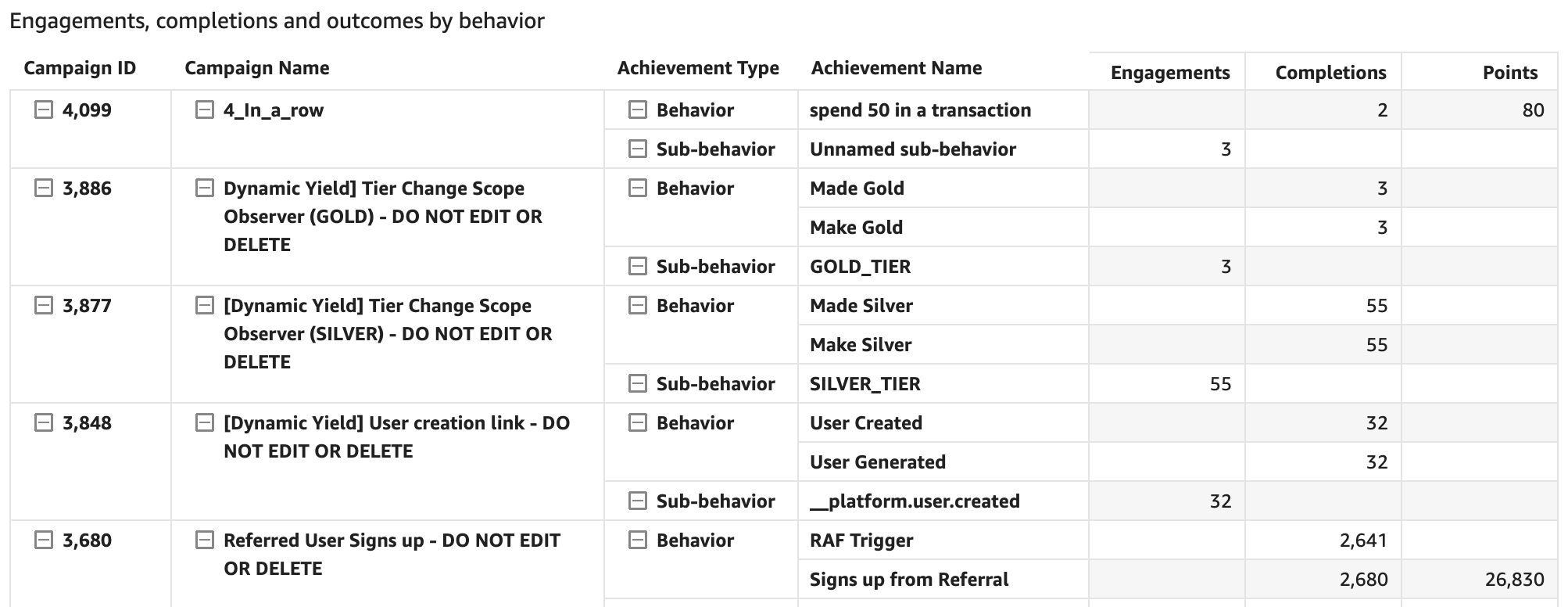Reward members at risk of tier downgrade with bonus points on partner purchases

An ounce of prevention is worth a pound of cure. This admonition, while old, is as true today as when it was first given. Acquiring a new consumer is five to twenty-five times more expensive than retaining an existing one. Successful loyalty programs implement proactive retention and reactivation programs to identify at-risk members and re-engage them with tailored promotional campaigns.
Take, for example, members at risk of tier downgrade. Tier-based loyalty programs evaluate their member's status on a regular basis (typically yearly) to determine which members have not reached the required point threshold and should be demoted to a lower tier.
Downgrades are difficult for both the member and the sponsor. The member may be alienated by the downgrade and feel a diminished sense of loyalty. The sponsor may feel a sense of disappointment that the member is not more engaged with the loyalty program. Therefore, take action to prevent tier downgrades from being necessary. Determine how best to re-engage lagging members. For example, an exclusive offer can help re-ignite spending.
Strategy
Reward members at risk of tier downgrade with discounts on partner purchases.
Here’s the scenario: The Koalla Retail loyalty program conducts tier maintenance once a year in the fall. In July, Koalla identifies members who are trending towards a tier downgrade (several months before tier maintenance occurs in September). It then runs a campaign offering quadruple bonus points for purchases its members make from its co-brand partners during the month of August.
Koalla's goal is to encourage spending (and rack up the associated points needed to stay in the Silver tier) by offering incentives on products and services beyond its own catalog. In addition, the co-brand partners benefit from increased sales and the possibility that Koalla members become regular consumers of their products. Let’s look at how to implement this scenario in the SessionM platform.
SessionM solution
The SessionM loyalty platform enables you to forge stronger, more loyal and more profitable relationships with your members. The platform provides an integrated set of capabilities - including data management, loyalty management, offer management, campaign orchestration, and analytics & optimization - that enable you to build compelling member loyalty programs.
Key modules
The strategy described in this article uses the following modules:

Audience
Segmentation
- Member base segmented and grouped by demographic and behavioral data in real time
- Built with standard demographic attributes (age gender, state) and custom behavioral attributes (customer lifetime value, risk of churn, and recency, frequency, monetary spend (RFM) metrics
- Member profiles stored in SessionM Customer module

Offer
Management
- Single use, multi-channel closed loop offers
- Define offer type, value and restrictions
- Select eligible menu items
- Real-time validation at POS
- Comprehensive offer reporting and tracking

Campaign
Orchestration
- Manage scheduled and behaviorally triggered campaigns across email, push, SMS, digital channels
- Real-time interaction management
- Rules-based promotions
- Centralized and actionable campaign analytics
See SessionM Features for a full discussion of SessionM platform features and functions.
Implementation workflow
The following procedure describes the workflow for implementing the loyalty program described in this article. The procedure captures the workflow at a high-level, providing you with a sense of the scope involved in implementing this program in the SessionM platform.

Take note
In addition to the core SessionM capabilities, this strategy leverages the optional Co-brand Optimizer feature. Co-brand Optimizer integrates the core SessionM loyalty capabilities with the co-branded credit card capabilities provided by the Mastercard Reward System (MRS) . Co-brand Optimizer enables outside spend transactional data collected by MRS to be ingested in the SessionM platform.
Most loyalty solutions force brands to manage their co-brand programs separately from their multi-tender loyalty programs. Credit card issuers typically only share minimal data with co-brand merchant partners (for example, total monthly points earned from the co-brand spend). And shared data is typically transmitted using manual batch files.
With Co-brand Optimizer, brands can manage their co-brand program as one component of the larger tender-neutral loyalty program. Co-brand Optimizer enables co-brand transactional data to be fed into SessionM so that merchants receive an ongoing feed of their customers’ outside spend activity. Merchants can leverage this enriched transactional data to unlock enhanced use cases for card acquisition, engagement and offers that the merchant can set-up and run directly.
The initial implementation of Co-brand Optimizer functionality is a managed service provided by the Mastercard team, moving to a client self-serve option once data flow connectivity between SessionM/MRS is fully complete in earrly 2024.
Step 1. Economy Rules module: Tiered loyalty program in place
For the following implementation workflow, assume that the Koalla Retail tiered loyalty program is in place. (See How do tiers work in a loyalty program? for a description of the Koalla Retail loyalty program.) The point economy has been set up, the tier structure is in place, and the rules and incentives have been defined for each tier. Members receive one point for each dollar spent (including on discounted items) and must have at least 1,000 points to belong to the Silver tier.
Step 2. Audience Composer Module: Build "Silver at Risk of Downgrade" audience
Identify those members in the Silver tier whose point balance has dropped below 1,000 so that you can target them with discounts for co-brand purchases.
-
Define the audience. Name the audience "Silver at Risk of Downgrade".
-
Use the Current Tier card to select the loyalty program to which the member belongs and the tier in which they reside. The resulting card criteria becomes: User's current tier in point economy Koalla Tier System is Silver.
-
Use the Point Balance card to set the range for the point balance that members must fall within to be included in the audience. Since the Silver tier starts at 1,000 points, the value would be "less than 1,000 points". The resulting point balance card criteria becomes: "User point balance in point account Koalla Spendable Points is less than 1,000."
-
Save and activate the audience, making it available for use in the campaigns below.
Step 3. Campaigns module: Create promotional campaign that defines purchase rule
-
Create a promotional campaign that defines the purchase rule for this promotion. Name the campaign and set its runtime for the month of August.
-
Target the campaign to the "Silver at Risk of Downgrade" audience created in step 1.
- Define the behavior for the campaign. Recall that the Silver tier has a purchase rule that awards 2 points for every dollar spent. To award "double points', define a purchase rule (in this campaign) that awards an additional 2 points for every dollar spent using a co-branded Mastercard during this promotion. Add an outcome for the behavior, which is the point award.
- Launch the campaign. Silver tier members receive double points on partner purchases in August.
Step 4. Campaigns Module: Define "Stay in Silver" messaging campaign
Create a messaging campaign that alerts the "Sliver at Risk" audience that they are within 100 points of being removed from the Silver tier and informs them about the available co-brand discounts.
-
Navigate to the Campaigns module and create a new messaging campaign.
-
Set the campaign's runtime from the beginning of July to the end of August. This runtime gives at-risk members sufficient time to restore their point balance.
-
Target the campaign to the "Silver at Risk of Downgrade" audience created in step 1.
-
Define the messaging type and delivery method. Add an external message. Set the delivery method to "Scheduled". Set the delivery date and time to the day that the campaign launches. Set the message to repeat weekly. This means that each week the message is re-sent to members who are still at risk of downgrade. (Members who have surpassed the 1,000 point threshold are dropped from the targeted audience and therefore do not receive the repeated message.)
-
Launch the messaging campaign.
Analysis
Successful loyalty programs adapt and evolve. It’s crucial to evaluate your program to determine where it is performing well and where it needs to improve. Built on a series of intuitive dashboards, the SessionM Insights reporting & analysis tool enables you to understand program performance by measuring key performance indicators such as customer spend and customer frequency.
This strategy challenges under-performing members to spend more by providing a time-sensitive reward of 4x points. The Campaigns dashboard serves as a visual tool to gain insights across past and current campaigns. The dashboard provides you with the ability to dive into a specific campaign, or compare key performance indicators (KPIs) across multiple campaigns. The visualization below reports all unique engagements, completions, and total points issued for each behavior set up for a campaign.

For detailed information on SessionM Insight features and functionality, see About Insights in the SessionM Help Center.

Key takeaways
Be proactive. Reach out to members at risk of tier downgrades
Identifying and reaching out to members whose engagement is declining is critical to a thriving loyalty program. Acquiring a new consumer is five to twenty-five times more expensive than retaining an existing one. Successful loyalty programs implement retention and reactivation programs to identify at-risk members and re-engage them with tailored promotional campaigns.
Build stronger relationships through smarter co-brand programs
Having a co-branded Mastercard can lead to substantial growth in loyalty. It attracts new members while lowering acquisition costs. Existing members are less likely to turn to your competitors as they know they can reap better benefits and rewards if they make their purchases using your co-branded Mastercard.